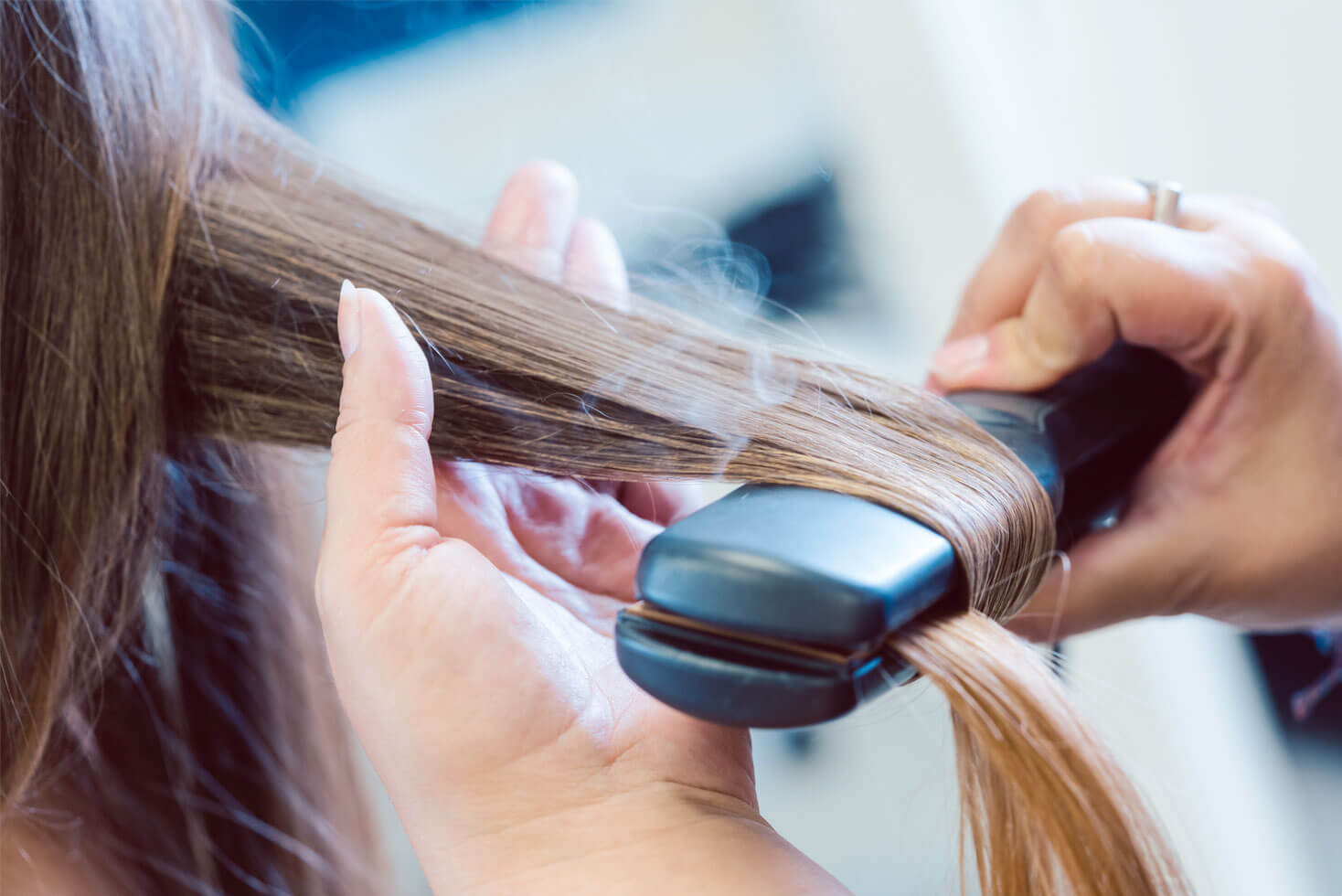At What Temperature Does Hair Burn? A Guide to Follicle-Damaging Heat
Updated on
This post may contain affiliate links. As an Amazon Associate, we may earn from qualifying purchases.

Human hair burns at the same temperature as paper: 451° F (233° C.)
Hitting above this will melt your hair shaft, causing all sorts of problems like:
- Dry and brittle hair
- Excess frizz
- Breakage
- Split ends
Straighteners, dryers, heated brushes – any tools that use heat to style hair, if not used properly, can cause irreversible heat damage.
I wrote this article after reading and analyzing studies on the behavior of heat on human hair to find out the best and safest temperatures for heat styling. [1]
Because it’s shocking to learn how many of us blast our wet mops with the highest heat settings just to get ready at the click of a switch!
In fact: I am guilty of this too!
Yes, dandy hot tools are perfect for straightening every last kink out or transforming your curls into straight and smooth styles …
But, are you respecting your hair’s heat tolerance?
Can your hair type handle the same heat as someone with super coarse and thick hair?
The answer is NO.
Everyone’s hair is different. Your hair might be more damaged, brittle, and sensitive depending on its health and how much heat you’ve used over the years.
So how do you find out the safest temperature to straighten your hair?
It’s simple.
Use temperatures below the melting point of hair.
What Temperature Does Hair Burn and Why is it Important to know
While it’s proven that hair burns at 451° F, my aim here is to show you how human hair reacts to different temperatures and different lengths of exposure to heat.
Because heat damage does not only happen from heat settings, you also have to factor in the length of time, intensity, and concentration of the heat you are using on your hair.
To understand the damaging impact of heat on human hair, we looked into a thorough study done by Elizabeth Pangerl and Katherine Igowsky from the Minnesota Bureau of Criminal Apprehension.
This study shows numerous hair samples undertaking simulations to comprehend variables such as:
- Heating rate
- Time of heat exposure
- And the methods of imparting heat to the hair
to understand how heat exposure can manifest changes in the hair structure, and how the hair shafts expand and contract with heat.
Here is a summary and results of 4 different studies:
- Study 1: Central bubbling and brittle hair at 400° F (325° C)
- This study exposed hair samples at 400° F.
The samples showed distal darkening and characteristics of central bubbling in 2 of 3 types of hair. - Study 2: Subtle darkening in color at 200° F (175° C)
- In this study, samples of hair were exposed to heat as low as 200° F (175° C). Researchers noticed a subtle darkening in the hair color and changes along the entire length of hair at 300° F.
- Study 3: Bubbling and discoloring at 190° C
- In this study, samples of hair were exposed to a maximum of 200° C. Minor changes like bubbling and discoloration were noticed, but they were not consistent throughout the length of the strands.
- Study 4: Total discoloration at 250° C
- In this study, samples of hair exposed to a maximum of 250° C showed total discoloration, expansion, and bubbling. All hair types tested showed signs of bubbling and discoloration.
To conclude, heated tools should be tested against a piece of paper for excessive heat before using it directly on the hair. If the device scorches paper, then it’s too hot for your hair. The accepted auto-ignition point of paper is 451° F or 233° C.
Go above 233° F, and your hair could suffer from severe side effects and damage.
Let me explain how excess heat affects your hair in many ways.
Side Effects of Excess Heat on Hair
Dry and brittle hair
One of the leading causes of dry and brittle hair is regular heat-styling[/ext] from electric curling irons, straighteners, or curlers.
Dull hair color
According to Francesca Fusco M.D., Dermatologist at Wexler Dermatology, the number one culprit that makes our hair look dull is straightening and curling.
Unfortunately, even if we don’t accept it, the heating tools we use for styling dims our hair’s shine.
Also, the weakened ridges along the hair are commonly caused by what we call Trichorrhexis nodosa, which is a common form of breakage that is instigated by overheating, and chemically treating the hair making it frail along the shaft.
Bubble hair
Bubble hair happens when the hair shaft starts to swell inside due to excess heat and steam from heat styling tools.
The swelling inside the hair is caused by bubbles which expand within to crack the inner hair structure, therefore, destroying the hair’s integrity.
Read: Is your hair straightener giving you bubble hair?
Loss of natural curls
One of the leading causes that damage your curls is heat damage. Heating appliances like flat irons, blow-dryers diminish the moisture from the surface of your hair cuticles, subsequently following a brittle, dry texture, which becomes susceptible to breakage.
Read: How to recover curly hair from heat damage.
Hair breakage and hair loss
While this may not be immediately noticeable, consistent use of heat on hair makes your hair fragile over time.
Fragile hair becomes vulnerable to breakage from mechanical styling, and over time you will notice less volume and thinning patches, which look like minor hair loss.
How To Prevent Burning Your Hair With Straighteners
Based on a study commissioned by GHD, the optimum temperature to style your hair is 365° F (185° C.)[/ext]
At this temperature, heat does not reach the melting point of hair, and does not create cracks and bubbles inside the structure.
However, GHD also emphasizes on using the right tools that are smart enough to protect your hair from heat exposure.
Let me explain …
You may be using a lower temperature, but if you keep the device too long on your hair, the concentration of heat may still damage your hair shafts.
To prevent damage and over-exposure to unsafe heat, GHD has invented a new range of heat styling tools to prevent heat damage.
For example:
The GHD Platinum hair straightener, the new generation of heat stylers with smart and intelligent sensors that can detect when your hair is being exposed to too much heat.
GHD Platinum Hair Straightener
The platinum styler comes with a single heat setting: 365° F (185° C), therefore, limiting its users to optimum heat. You don’t have to figure it out every day and keep changing temperatures, which is where most of us get it wrong.
Intelligent Heat Sensors
The Platinum straightener from GHD has 3 built-in sensors across the plates to ensure the temperature remains constant. Without fluctuations in heat, the device styles your hair faster, therefore, cutting down on the time you have to sandwich your hair between hot plates.
Here are some of the benefits of using this tool:
- Heat sensors cut out concentrated heat on the hair
- Even heat distribution styles hair faster
- Precision-finished plates transfer heat more efficiently
Check out how it compares in our best hair straighteners guide.
Conclusion
Remember, the key to using a heat styling tool effectively and getting hair styled fast is not by turning up the heat.
It is by using smart tools that intelligently deliver heat through controlled surfaces like glass and tri-zone technology to protect your hair while also staying in the safe heat zone.
With the GHD Platinum Styler, you won’t have to worry about follicle-damaging heat.
Your hair will always be between a pair of safe plates.
GHD Platinum Hair Straightener
References & Citations
1. Igowsky, E. P. (n.d.). projects.nfstc.org. Elizabeth Pangerl and Katherine Igowsky. Retrieved 12 3, 2019
https://projects.nfstc.org/trace/docs/Trace%20Presentations%20CD-2/Pangerl.pdf
2. Dr. Tim Moore, GHD chief technology officer. Retrieved 12 3, 2019
https://www.ghdhair.com/articles/dispelling-the-heat-styling-myth
Dispelling the heat styling myth.
About the Author
 Shehnaz Shirazi
Shehnaz ShiraziShehnaz Shirazi has been writing in the beauty and cosmetics industry for over 8 years, sharing her expansive hair care and beauty knowledge. Shehnaz researches and tests new hair care trends and publishes her insights here.
